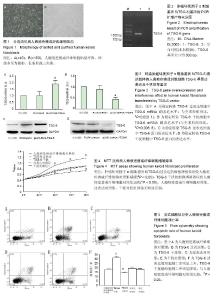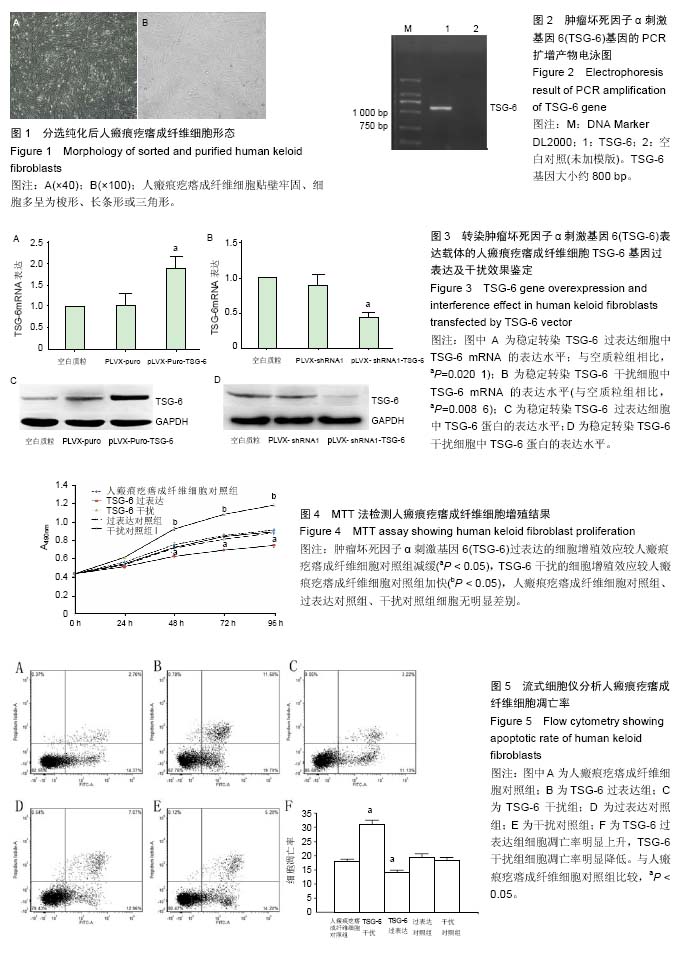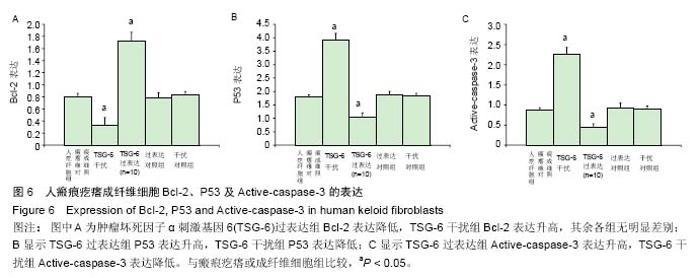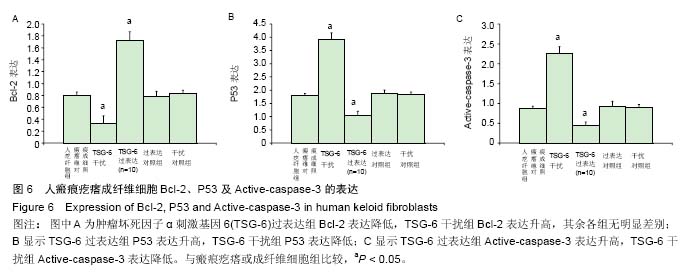| [1] Theoret C. Tissue engineering in wound repair: the three "R"s--repair, replace, regenerate.Vet Surg.2009; 38(8):905-913.
[2] Wang J, Dodd C, Shankowsky HA, et al. Deep dermal fibroblasts contribute to hypertrophic scarring.Lab Invest. 2008;88(12):1278-1290.
[3] Mak K, Manji A, Gallant-Behm C, et al. Scarless healing of oral mucosa is characterized by faster resolution of inflammation and control of myofibroblast action compared to skin wounds in the red Duroc pig model.J Dermatol Sci.2009;56(3):168-180.
[4] 韦俊,陆树良. 炎症与胎儿皮肤无瘢痕愈合关系的研究[J]. 感染、炎症、修复,2010,11(2):112-114.
[5] Gauglitz G G, Korting HC, Pavicic T, et al. Hypertrophic scarring and keloids: pathomechanisms and current and emerging treatment strategies.Mol Med.2011; 17(1-2): 113-125.
[6] Lee TH, Lee GW, Ziff EB, et al. Isolation and characterization of eight tumor necrosis factor-induced gene sequences from human fibroblasts.Mol Cell Biol. 1990;10(5):1982-1988.
[7] Klampfer L, Lee TH, Hsu W, et al. NF-IL6 and AP-1 cooperatively modulate the activation of the TSG-6 gene by tumor necrosis factor alpha and interleukin-1. Mol Cell Biol.1994;14(10):6561-6569.
[8] Lee TH, Wisniewski HG, Vilcek J. A novel secretory tumor necrosis factor-inducible protein (TSG-6) is a member of the family of hyaluronate binding proteins, closely related to the adhesion receptor CD44.J Cell Biol.1992;116(2):545-557.
[9] Milner CM, Higman VA, Day AJ. TSG-6: a pluripotent inflammatory mediator?[J]. Biochem Soc Trans.2006; 34(Pt 3):446-450.
[10] Danchuk S, Ylostalo JH, Hossain F, et al. Human multipotent stromal cells attenuate lipopolysaccharide- induced acute lung injury in mice via secretion of tumor necrosis factor-alpha-induced protein 6.Stem Cell Res Ther.2011;2(3):27.
[11] Tan KT, Mcgrouther DA, Day AJ, et al. Characterization of hyaluronan and TSG-6 in skin scarring: differential distribution in keloid scars, normal scars and unscarred skin.J Eur Acad Dermatol Venereol.2011;25(3):317-327.
[12] 王晖,李小静,陈钊. 抗炎因子TSG-6 抑制兔耳瘢痕增生的实验研究[J]. 安徽医科大学学报,2015,50(1):45-49.
[13] 骆建民, 俐.人真皮原代成纤维细胞的培养、鉴定及蛋白酶活性受体的表达[J]. 解剖学研究,2007,29(1):33-37.
[14] 杨志明.组织工程学[M]. 北京:化学工业出版社, 2002: 155-158.
[15] 曹晨华,纪丽曼,耿娅,等.人皮肤成纤维细胞系的鉴定及老化检测[J].河北医药,2009,31(16):2040-2042.
[16] Russell SB, Trupin KM, Rodriguez-Eaton S, et al. Reduced growth-factor requirement of keloid-derived fibroblasts may account for tumor growth.Proc Natl Acad Sci U S A.1988;85(2):587-591.
[17] Muir IF. On the nature of keloid and hypertrophic scars.Br J Plast Surg.1990;43(1):61-69.
[18] Leibovich SJ, Ross R. The role of the macrophage in wound repair. A study with hydrocortisone and antimacrophage serum.Am J Pathol.1975;78(1):71-100.
[19] Burrington J D. Wound healing in the fetal lamb.J Pediatr Surg.1971;6(5):523-528.
[20] Armstrong JR, Ferguson MW. Ontogeny of the skin and the transition from scar-free to scarring phenotype during wound healing in the pouch young of a marsupial, Monodelphis domestica.Dev Biol.1995; 169(1):242-260.
[21] Wilgus TA, Bergdall VK, Tober KL, et al.The impact of cyclooxygenase-2 mediated inflammation on scarless fetal wound healing.Am J Pathol.2004;165(3):753-761.
[22] Peranteau WH, Zhang L, Muvarak N, et al.IL-10 overexpression decreases inflammatory mediators and promotes regenerative healing in an adult model of scar formation.J Invest Dermatol.2008;128(7):1852-1860.
[23] Milner CM, Day AJ. TSG-6: a multifunctional protein associated with inflammation.J Cell Sci.2003;116 (Pt 10):1863-1873.
[24] Oh JY, Roddy GW, Choi H, et al. Anti-inflammatory protein TSG-6 reduces inflammatory damage to the cornea following chemical and mechanical injury.Proc Natl Acad Sci U S A.2010;107(39):16875-16880.
[25] Bardos T, Kamath RV, Mikecz K, et al. Anti-inflammatory and chondroprotective effect of TSG-6 (tumor necrosis factor-alpha-stimulated gene-6) in murine models of experimental arthritis.Am J Pathol. 2001;159(5):1711-1721.
[26] Choi H, Lee RH, Bazhanov N, et al. Anti-inflammatory protein TSG-6 secreted by activated MSCs attenuates zymosan-induced mouse peritonitis by decreasing TLR2/NF-kappaB signaling in resident macrophages. Blood.2011;118(2):330-338.
[27] Larson BJ, Longaker MT, Lorenz HP. Scarless fetal wound healing: a basic science review.Plast Reconstr Surg.2010;126(4):1172-1180.
[28] 付思祺, 范金财. 白细胞介素在瘢痕形成中的作用[J]. 中国美容整形外科杂志,2012,23(3):167-169.
[29] Wang H, Chen Z, Li XJ, et al. Anti-inflammatory cytokine TSG-6 inhibits hypertrophic scar formation in a rabbit ear model.Eur J Pharmacol.2015;751:42-49.
[30] Park J R, Hockenbery D M. BCL-2, a novel regulator of apoptosis.[J]. J Cell Biochem,1996,60(1):12-17.
[31] 刘勇, 任林森, 岑瑛. Bcl-2和Fas基因在瘢痕成纤维细胞中的表达[J]. 中国修复重建外科杂志,2001,15(6):351-353.
[32] Moreira JN, Santos A, Simoes S. Bcl-2-targeted antisense therapy (Oblimersen sodium): towards clinical reality.Rev Recent Clin Trials.2006;1(3):217-235.
[33] 唐悦玲,李小静,陈钊, et al. TSG-6对病理性瘢痕成纤维细胞凋亡的影响[J]. 中国美容整形外科学杂志,2014, 25(3):157-160.
[34] Suzuki K, Matsubara H. Recent advances in p53 research and cancer treatment. J Biomed Biotechnol. 2011;2011:978312.
[35] 陈文琦,许惠娟,毕志刚. RNA干扰p53基因表达对人皮肤成纤维细胞衰老的影响[J].中华皮肤科杂志,2012,45(11): 799-802.
[36] 黄勇,陈静,林立新,等. 瘢痕成纤维细胞凋亡及p53基因的表达[J]. 中华医学美学美容杂志,2003,9(1):33-35.
[37] Hemann MT, Lowe SW. The p53-Bcl-2 connection.Cell Death Differ.2006;13(8):1256-1259. |



